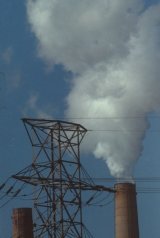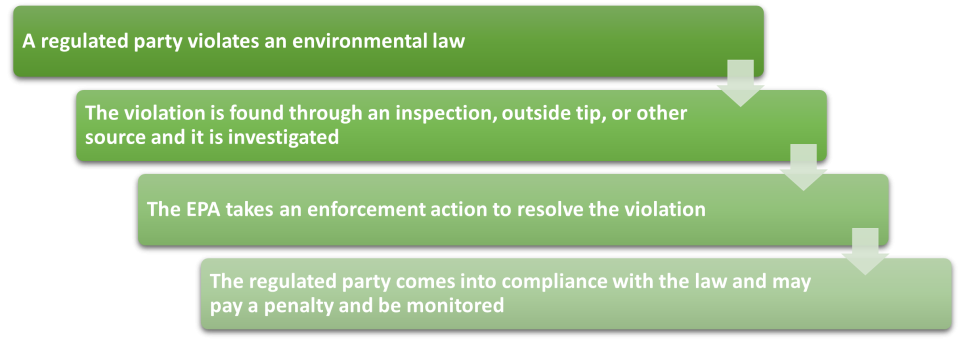Fact Sheet: EPA’s Civil Enforcement Program
September 2024
Updated June 2025
Enforcing our nation’s environmental laws and regulations serve as the U.S. Environmental Protection Agency’s foundation for protecting human health and the environment. Most of these laws contain both civil and criminal provisions which give the agency the authority to take action against violators of those laws. Through the enforcement program, EPA holds polluters accountable and strives to have them prevent reoccurrence and, in appropriate cases, reduce the harm to the communities impacted by their actions.
| Key Laws the EPA Enforces | |
|---|---|
American Innovation and Manufacturing (AIM) Act Asbestos Hazard Emergency Response Act (AHERA) Clean Air Act (CAA) Clean Water Act (CWA) Comprehensive Environmental Response, Compensation, and Liability Act (CERCLA) Emergency Planning and Community Right-to-Know (EPCRA) | Federal Insecticide, Fungicide, and Rodenticide Act (FIFRA) Oil Pollution Act (OPA) Residential Lead-Based Paint Hazard Reduction Act Resource Conservation and Recovery Act (RCRA) Safe Drinking Water Act (SDWA) Toxic Substances Control Act (TSCA) |

The civil enforcement program is responsible for ensuring that regulated parties (such as businesses, federal entities, and individuals) follow the laws and regulations for air and water pollution, hazardous and solid waste, drinking water contamination, exposure to lead, asbestos, pesticides, and other toxic chemicals, and much more.
Breaking the law on purpose may bring criminal enforcement actions, which can result in jail time, fines, and/or restitution by the violator. EPA may also work with other federal departments and agencies, and state, Tribal, and territorial government partners to investigate violations, and to initiate and resolve an enforcement action.
This fact sheet highlights the basics of EPA’s civil enforcement program and includes information on how you can report potential environmental violations.
What is a violation?
An environmental violation occurs when a company or person doesn’t follow an environmental requirement found in a law or regulation. Examples include:
- Dumping or spilling pollutants or unsafe substances into a water resource without the required permit.
- Not having the required pollution controls to manage the release of pollutants into the air.
- Improperly disposing or transporting hazardous waste and substances.
What happens when a regulated party violates the law?
There are consequences! Even if a company or person does not know about the law or regulation they violated, they are still accountable for not following that law or regulation.
EPA has the authority to collect information from a variety of sources to determine if a violation has occurred. Often, violations are discovered through inspections, reporting requirements, and tips and complaints from the public. Generally, each violation is unique, and EPA determines the appropriate enforcement action to take on a case-by-case basis based on EPA’s findings.
Civil enforcement at the EPA generally follows this process:

The length of the enforcement process depends on the number and type(s) of violations. Though many cases are resolved quickly, sometimes the case takes years to resolve if the violator does not agree with EPA’s findings which can lead to a lengthy court case.
What are the results of an enforcement action?
Once EPA collects evidence showing that a regulated party violated an environmental law or regulation and notifies them, the agency first tries to resolve the violations through a settlement. A settlement is an agreement between the EPA and the violating party to resolve an enforcement case without needing a legal hearing. If a settlement agreement can’t be reached, it can turn into a legal hearing or trial (with the help of the U.S. Department of Justice). Most enforcement actions are resolved through settlements versus a hearing or trial.
There can be different parts to a settlement agreement, all of which are meant to hold the violator accountable. These may include:
- Civil Penalties – which are monetary penalties or fines imposed on a regulated party based on the violation(s) and paid to the U.S. Treasury. Civil penalties are a way to collect against the profit gained by a company or person who did not follow the law, and to discourage future violations.
- Injunctive Relief – which is the settlement term that means a regulated party may have to take or stop an action to address, reduce, or offset the harm to human health or the environment caused by the violation(s). This may include different tools to address the violation and ensure future compliance with environmental laws and regulations.
- Supplemental Environmental Projects (SEPs) – which are environmental improvement projects that a regulated party can volunteer to perform in addition to the actions required to correct the violations specified in the settlement.
How can you and your community get involved?
EPA works to address the water, air, land, and chemical violations and hazards that impact communities across the country. Depending on the violation, EPA may engage with the community when enforcement activities are happening for input or to share information on the case. However, EPA cannot share information with the community that will interfere with a current investigation. The release of sensitive enforcement information can negatively impact case outcomes, settlement negotiations, and public health and the environment. Here are a few ways the community can contribute to the environmental enforcement process:
Report a Violation:
- Report a violation using the EPA’s Report Environmental Violations tool.
- If you are seeing an environmental event that may lead to an immediate threat to human health or the environment, call 911, then report it to the National Response Center at 1-800-424-8802. To learn the difference between a possible violation and an emergency, visit the How to Report Spills and Environmental Violations webpage.
- To submit a tip by phone, please contact your EPA regional office. Phone numbers for each region are available on the EPA’s How to Report Spills and Environmental Violations webpage.

Check Facility Compliance Status: Facilities are “in compliance” when they successfully follow environmental rules and regulations. Visit the EPA’s Enforcement and Compliance History Online (ECHO) database.
To learn more about the EPA’s enforcement efforts and results visit the Agency’s Enforcement and Compliance websites.
Disclaimer: This fact sheet does not replace or revise any of the EPA regulatory provisions or any other part of the Code of Federal Regulations, the Federal Register, or the nation's environmental laws. This fact sheet shall not be relied upon by any regulated entity in defense of or in response to any enforcement actions brought against the entity by the EPA or any local regulating agency.
